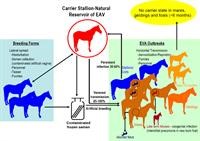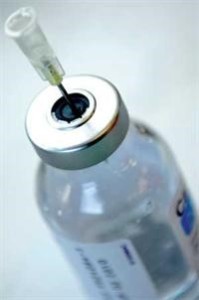Written by David P. Beehan, DVM Sara K. Lyle, DVM, PhD, DACT Neely Walker, PhD
Original Publish Date August 2015
An effective vaccine is available to prevent and control EVA.
Equine Viral Arteritis (EVA) is a worldwide disease that causes mild respiratory disease and abortion in horses.
Epidemiology:
It was first diagnosed in 1953 on a stud farm suffering respiratory disease and abortions in Ohio. Since then it has been reported across America mainly on breeding farms. It may cause an abortion rate of up to 50% in pregnant mares exposed to the virus for the first time. It has been reported in all breeds of horses, but seems to be particularly prevalent in Standardbred horse populations. Surveys have shown that between 70% and 90% of Standardbred mares have been exposed (have a titer to the EVA virus).
Horses are the only host of EVA virus, and all ages and sexes are susceptible. The disease will spread rapidly in susceptible horse populations, resulting in high morbidity and low mortality rates. Clinical signs can be so mild that the disease is not readily apparent. Most horses will recover and affected horses will attain prolonged immunity from disease. However infected stallions may continue to shed virus in ejaculates without other clinical signs.
Transmission:
The virus is shed in the respiratory secretions of affected horses, and can remain viable for long periods in the environment. Susceptible mares can be infected by inhalation of respiratory secretions from infected horses. Typical locations where exposure and transmission will occur would be sales-barns and racetracks. Abortion may occur 3 to 9 weeks after exposure.
Infected stallions play a major role in the spread of EVA. Infected stallions can be long-term shedders resulting in the venereal spread of EVA to susceptible mares. Stallions can remain carriers for weeks to years. Mares are not considered to be long-term shedders, but infected mares can spread the disease to other susceptible mares by direct contact. Other reported modes of transmission include fomites (inanimate objects capable of holding a virus), teaser stallions and the fetal fluids of an aborted fetus.
Pathogenesis:
The EVA virus has predilection for the cells that line blood vessels. After inhalation, the virus will spread from the lungs to lymph nodes before entering the bloodstream resulting in a viremia (infection within the bloodstream). The virus will then replicate in the endothelial cells, resulting in damage to the blood vessel. It is this damage that results in many of the clinical signs associated with EVA, e.g. edema, hemorrhage and abortion. Over the years, the virus has become much less virulent than what was seen in 1953. At that time, the EVA virus produced very severe disease, with mortality rates approaching 50%.
Clinical Signs:
Infections with EVA typically result in subclinical or mild respiratory disease and sporadic abortions. EVA has an incubation period of 3-14 days until clinical signs become apparent. These may include; fever, leucopenia (decreased white blood cells), serous nasal discharge, conjunctivitis (swelling of the membranes lining the eyelids, purulent ocular discharge, palpebral edema (eyelid swelling), photophobia (sensitivity to light), skin rash, nasal mucosal petechiation (small purplish spots on the mucus membranes within the nose). Some severe respiratory cases may result in coughing and dyspnea (shortness of breath). Edema may also be present in the limbs, ventral abdomen, scrotum and prepuce. Other reported clinical signs include anorexia, depression, weight loss, abdominal pain and diarrhea.
Abortion usually occurs 10 days after maternal illness. Abortions may occur between 5-10 months of gestation. Between 40% and 80% of pregnant mares with no prior exposure to EVA virus (seronegative status) will abort.
Diagnosis:
EVA cannot be diagnosed by clinical signs alone. It must be differentiated from other causes of viral respiratory disease e.g. equine herpesvirus and equine influenza. Samples required for submission for diagnosis include nasopharyngeal (nasal part of the pharynx) swabs, blood, urine and aborted fetal tissues.
Control:
An effective vaccine is available to prevent and control EVA. All breeding stallions should be vaccinated at least 60 days before the breeding season. Infected stallions (presumed shedders of the virus) should only be bred to seropositive or vaccinated mares. If vaccinated mares are to be bred to an infected stallion, they should be vaccinated at least three weeks in advance, and the mare (and her foal if she is nursing) should then be kept in isolation from unvaccinated susceptible mares for three weeks. Mares should not be vaccinated during the last two months of gestation. Foals can be vaccinated at weaning or at 6 months. If you would like your horse tested or vaccinated for please contact:
Equine Health Studies Program School of Veterinary Medicine Louisiana State University Baton Rouge, LA 70803 Telephone: (225)-578-9500





